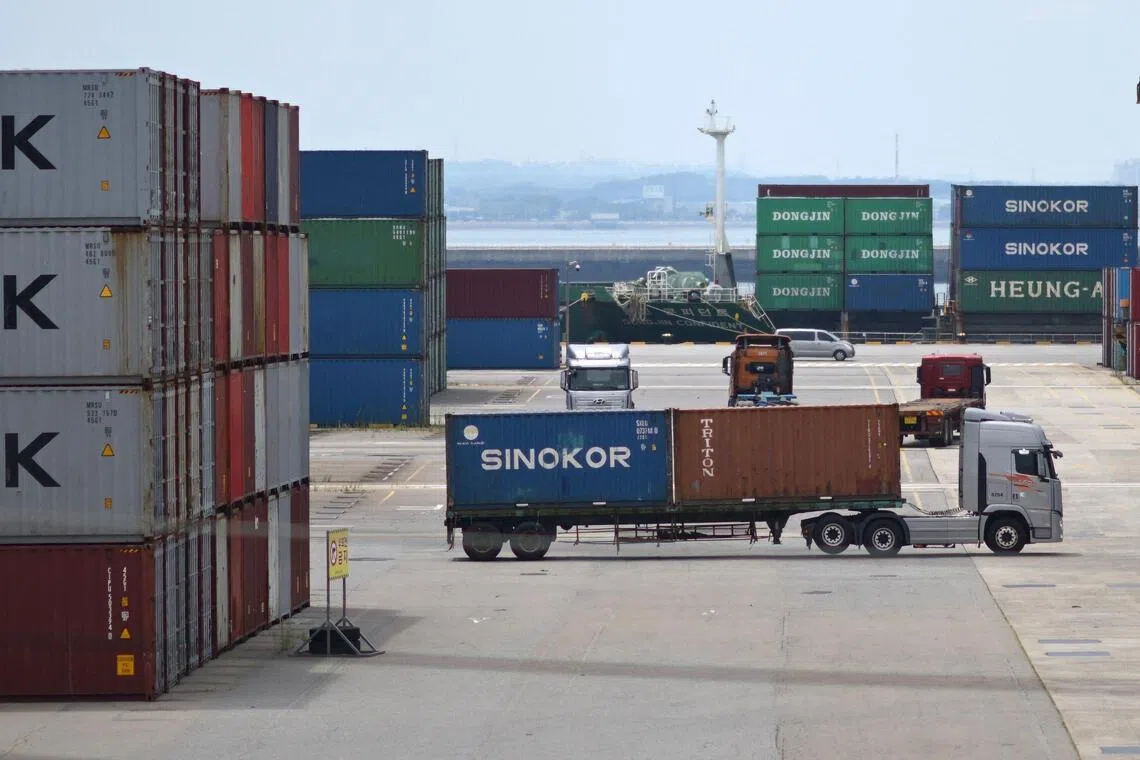South Korea’s early exports in September fall on tariffs, holiday effect
Sign up now: Get ST's newsletters delivered to your inbox

South Korea’s exports have held up so far in 2025, partly because manufacturers rushed to ship goods before US tariffs took effect in August.
PHOTO: AFP
Follow topic:
SEOUL – South Korea’s early exports looked weaker in September, weighed down by higher US tariffs and by the fact that companies front-loaded more shipments ahead of the Chuseok holiday in 2024, making 2025’s figures look smaller by comparison.
The monthly trade of Asia’s fourth-largest economy is considered a bellwether for world trade, and its data is the first to be released among major exporting economies.
The value of shipments adjusted for differences in the number of working days fell 10.6 per cent from a year earlier in the first 20 days of September, according to data released on Sept 22 by the Customs office. That compared with a revised 6 per cent increase reported for the full month of August adjusted for working days.
Unadjusted exports rose 13.5 per cent, while overall imports increased 9.9 per cent, resulting in a trade surplus of US$1.89 billion (S$2.4 billion).
The latest trade data shows a larger-than-usual gap between seasonally adjusted and unadjusted figures because of the shifting Chuseok holiday. The holiday in 2024 fell in September, pulling exports forward and leaving a high base that makes 2025’s daily average look smaller in comparison.
“Exports are expected to pick up significantly over the remaining 10 days ahead of the Chuseok holiday in October,” said Bloomberg economist Kwon Hyo-sung. “Shipments may slow compared with last month on a daily average basis, but not by much. The real question is how much momentum can be sustained after the Chuseok holiday.”
Tariff effects are expected to start weighing in the fourth quarter and the scale of any slowdown will be a key factor for the broader economic outlook and policy direction, Mr Kwon added.
Semiconductors, the main driver of exports in 2025, gained 27 per cent, extending the advance after a 30 per cent increase in August, while auto exports rose by about 15 per cent. Petrochemicals remained under pressure from tariffs and weaker global demand.
The latest data suggests exporters are still front-loading shipments to the US to an extent as businesses wait to see how President Donald Trump’s tariff campaign develops after the US in August imposed a 15 per cent universal tariff on South Korean goods. Smartphones and laptops remain exempt, but Mr Trump has warned that he may extend duties to semiconductors.
Exports to the US increased 6.1 per cent in September. Shipments to China gained 1.6 per cent, while those to India climbed 28.3 per cent and those to Taiwan rose almost 23 per cent.
South Korea’s exports have held up so far in 2025, partly because manufacturers rushed to ship goods before tariffs took effect in August. This front-loading provided a temporary lift, but with those early shipments now out of the way, exports are increasingly exposed to the drag from higher duties and slowing global demand.
Lingering uncertainty is also weighing on sentiment after an immigration raid that led to the detention of more than 300 Korean workers at a battery plant under construction in Georgia raised diplomatic tensions. While the detained workers were later released and sent home, the immigration sweep has further complicated Seoul’s trade talks with Washington.
Auto exports face added pressure, as the 25 per cent US tariff on South Korean cars remains in place until Mr Trump signs an executive order to align it with the 15 per cent universal rate. BLOOMBERG

